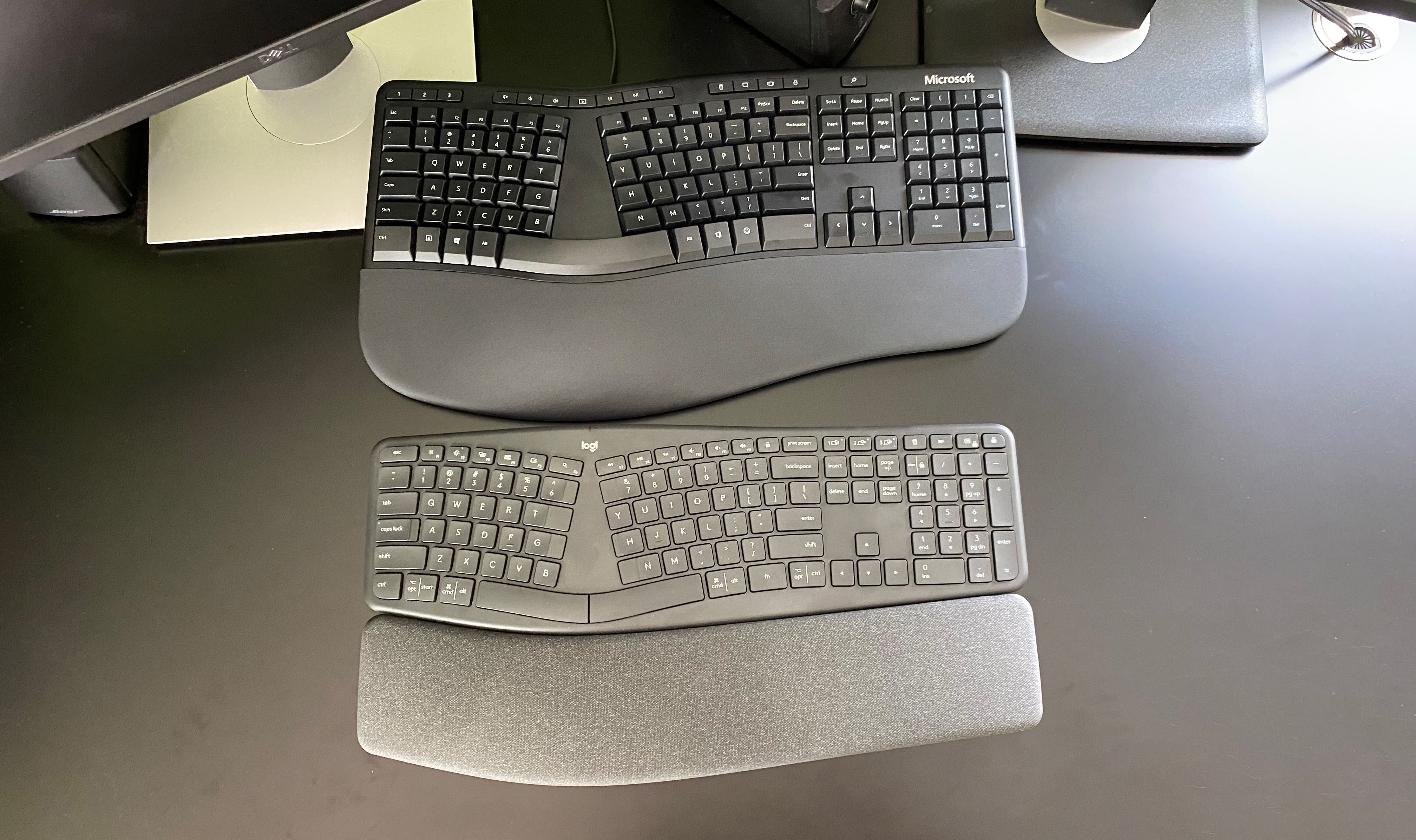When comparing split and traditional keyboards for ergonomics, split keyboards are generally considered better due to improved hand positioning and reduced strain. Split keyboards allow for a more natural wrist alignment, reducing the risk of repetitive strain injuries.
They also promote better posture and comfort during extended typing sessions. With adjustable angles and key layouts, split keyboards offer a customizable experience tailored to individual preferences. Traditional keyboards, on the other hand, may cause more strain on the wrists and shoulders due to a fixed layout.
Consequently, split keyboards are often recommended for users seeking ergonomic improvements and increased comfort while typing.
Traditional Keyboards
Traditional keyboards have been the go-to choice for many, but split keyboards are gaining popularity for their ergonomic benefits. With a split layout, these keyboards help reduce strain and promote a more natural hand position, making them a better option for improved ergonomics.
Traditional Keyboards
Traditional keyboards typically refer to the standard keyboards that have been widely used for typing on computers for several decades. These keyboards typically have a QWERTY layout, named after the first six letters in the top row of keys. They consist of alphanumeric keys, number keys, function keys (F1-F12), modifier keys (such as Shift, Ctrl, Alt), and various other keys like arrow keys, Enter, Backspace, and Delete.
Traditional keyboards can be wired or wireless, with most modern keyboards connecting to computers via USB or Bluetooth. They are designed for typing text and inputting commands efficiently. While the basic layout of traditional keyboards has remained largely unchanged over the years, there are variations and enhancements, such as ergonomic designs, mechanical switches for a more tactile feel, and additional features like multimedia keys and customizable macro keys.
Design and Layout
The design and layout of traditional keyboards typically consist of a single board with all the keys placed closely together. This layout can often lead to awkward wrist and hand positions, making it uncomfortable for extended periods of typing. The lack of separation between the keys can cause strain and fatigue on the hands and fingers.
Typing Experience
The typing experience on a traditional keyboard can vary based on personal preference, but the closely spaced keys may make it difficult for some individuals to type accurately and comfortably. This may lead to increased pressure on the fingers which can cause discomfort and strain after prolonged use.
Potential Ergonomic Issues
Using a traditional keyboard for an extended period can lead to various ergonomic issues including wrist strain, carpal tunnel syndrome, and repetitive strain injury. The design and layout of traditional keyboards may contribute to poor wrist and hand positioning, leading to these potential health problems over time.

Credit: www.cnn.com
Split Keyboards
Split keyboards and traditional keyboards offer different ergonomic benefits. While traditional keyboards allow for familiar typing positions, split keyboards promote a more natural and comfortable hand placement. Ultimately, the choice between the two depends on individual preferences and ergonomic needs.
Split keyboards, as the name suggests, are divided into two separate sections, allowing the user to customize the distance and angle between each half according to their comfort. The layout and design of split keyboards aim to reduce strain on the wrists and promote a more natural hand position. When it comes to ergonomics, split keyboards have distinct advantages, providing a unique typing experience that may benefit individuals who spend extended periods at a computer.
Design And Layout
Split keyboards are designed with a separation between the two halves, typically connected by a cable or wireless technology. This layout allows for a more natural hand positioning, reducing strain on the wrists and forearms. The adjustable distance and angle between the split parts enable users to find the most comfortable position for their hands, promoting a more ergonomic typing experience. As a result, users can minimize the risk of repetitive strain injuries and carpal tunnel syndrome.
Typing Experience
The typing experience on split keyboards differs from traditional ones, offering a unique feel and adjustment process. The divided layout allows for a more natural hand alignment, promoting a straighter wrist position while typing. This can contribute to reduced muscle tension and improved comfort during extended typing sessions. However, the adjustment period for new users may be required to adapt to the split layout, as it deviates from the standard keyboard design.
Advantages For Ergonomics
Split keyboards provide several ergonomic advantages, including improved wrist alignment, better support for natural hand positioning, and reduced strain on the forearms. By allowing users to customize the position of each half, split keyboards help promote a more comfortable and relaxed posture. Additionally, the ergonomic benefits of split keyboards may contribute to enhanced productivity and reduced discomfort during prolonged computer use, making them a favorable option for individuals seeking ergonomic solutions.
Comparing Ergonomic Benefits
Explore the Ergonomic Benefits of Split and Traditional Keyboards to determine which option best suits your needs for improved comfort and posture while typing. Assess the different designs to optimize your ergonomic experience and reduce the risk of strain and discomfort.
When it comes to choosing a keyboard that promotes better ergonomics, the decision between a split keyboard and a traditional keyboard can be perplexing. Both options have their strengths and weaknesses. In this section, we will delve deeper into the ergonomic benefits of each type to help you make an informed decision.
Wrist And Forearm Position
An important aspect of ergonomics is the position of the wrists and forearms while typing. With a traditional keyboard, the keys are aligned in a straight line, causing the wrists to be in a pronated position. This can result in strain and discomfort over time.
On the other hand, a split keyboard has a unique design that separates the keys into two separate halves. This allows for a more natural placement of the wrists and forearms. The keyboard can be adjusted to match the shoulder’s width and arm’s length, reducing strain on the wrists and promoting a more neutral position.
Shoulder And Arm Position
In addition to wrist and forearm position, the shoulder and arm position also play a crucial role in ergonomic typing. With a traditional keyboard, the keys are closely packed together, causing the arms to be positioned close to the body and the shoulders to hunch forward.
A split keyboard, on the other hand, allows for a wider placement of the keys. This wider spacing of the keys makes it easier to position the arms at shoulder-width apart, reducing shoulder strain and promoting a more relaxed and natural typing posture.
Reduction In Strain And Discomfort
The ultimate goal of an ergonomic keyboard is to reduce strain and discomfort during long hours of typing. While both split and traditional keyboards can offer ergonomic benefits, a split keyboard often surpasses the traditional one in terms of providing a more comfortable typing experience.
By allowing for a more natural alignment of the wrists, forearms, shoulders, and arms, a split keyboard helps reduce the risk of repetitive strain injuries (RSIs) such as carpal tunnel syndrome. It also promotes better blood circulation and minimizes muscle fatigue, allowing you to type for longer periods without discomfort.
In conclusion, when considering the ergonomic benefits, a split keyboard tends to outshine the traditional keyboard. Its unique design and adjustability provide a more comfortable and natural typing experience, reducing strain and discomfort associated with prolonged typing sessions.

Credit: dygma.com
Considerations For Choosing A Keyboard
Individual Needs And Preferences
Each person’s unique requirements play a crucial role in selecting the ideal keyboard.
- Evaluate your hand size and typing posture to determine the most comfortable design.
- Consider any existing wrist or hand-related issues that may influence your decision.
- Split keyboards may be more ergonomic for individuals with wrist strain or carpal tunnel.
Work Environment
Your work setting can impact the choice between a split and traditional keyboard.
- Highly versatile work environments may benefit from the portability of a traditional keyboard.
- Consider the space available on your desk and how each keyboard type fits into it.
- For shared workstations, a split keyboard may offer better adjustability.
Mobility And Portability
The need for mobility and portability should guide your decision when selecting a keyboard.
- Split keyboards may not be as convenient for travel due to their larger size and shape.
- Consider your typical work locations and whether a lightweight, compact keyboard is necessary.
Tips For Getting Started With A New Keyboard
- Familiarize Yourself with the Layout: Take some time to familiarize yourself with the layout of your new keyboard. Although most keyboards follow the QWERTY layout, there might be slight variations in key placement or additional features. Spend some time locating commonly used keys such as Enter, Shift, and Backspace.
- Customize Settings (if applicable): If your keyboard comes with customization options, such as programmable keys or lighting effects, consider adjusting them to suit your preferences. This can enhance your typing experience and productivity.
- Practice Typing Exercises: Engage in typing exercises and drills to help you become more comfortable with the new keyboard layout. There are numerous online resources and typing software programs available that offer exercises tailored to different skill levels.
- Use Typing Tutorials: Take advantage of typing tutorials and games to improve your typing speed and accuracy. These resources often provide interactive lessons and feedback to help you identify areas for improvement.
- Experiment with Key Presses: Get a feel for the key presses on your new keyboard. Some keyboards may have different types of switches (e.g., membrane, mechanical) that offer varying levels of tactile feedback and actuation force. Experiment with different key presses to find what feels most comfortable for you.
- Utilize Shortcut Keys: Many keyboards come with built-in shortcut keys or multimedia keys that allow you to perform tasks quickly and efficiently. Take the time to learn these shortcuts, as they can greatly enhance your workflow and productivity.
- Maintain Good Posture: Pay attention to your posture while typing. Sit up straight with your feet flat on the floor and your shoulders relaxed. Avoid slouching or hunching over the keyboard, as this can lead to discomfort and strain over time.
- Take Breaks: Remember to take regular breaks to rest your hands and eyes, especially during extended typing sessions. This can help prevent fatigue and reduce the risk of repetitive strain injuries.
- Stay Patient and Persistent: Learning to adapt to a new keyboard takes time and patience. Don’t get discouraged if you don’t see immediate improvement in your typing speed or accuracy. With consistent practice and perseverance, you’ll gradually become more proficient with your new keyboard.

Credit: www.nytimes.com
Frequently Asked Questions On Split Vs. Traditional Keyboards: Which Is Better For Ergonomics?
What Is The Most Ergonomic Keyboard Layout?
The most ergonomic keyboard layout is the split ergonomic keyboard, which helps reduce strain on your wrists and hands.
Which Keyboard Is More An Ergonomic Keyboard?
The more ergonomic keyboard is the one designed to reduce strain and promote comfort while the user types.
What Is The Most Ergonomic Way To Use The Keyboard?
The most ergonomic way to use the keyboard is to position it at elbow height, keep wrists straight, and use a light touch when typing. Take regular breaks and use a supportive chair to reduce strain on the body. Ergonomic keyboards and wrist rests can also help prevent discomfort.
Are Mechanical Keyboards Better For Ergonomics?
Yes, mechanical keyboards are better for ergonomics due to their tactile feedback and customizable switches. This can reduce strain on the fingers and wrists, leading to a more comfortable and efficient typing experience.
Conclusion
When it comes to ergonomic keyboards, both split and traditional options have their own merits. Split keyboards offer a more comfortable typing experience by reducing strain on the wrists and promoting a more natural hand posture. On the other hand, traditional keyboards provide a sense of familiarity and may be more suitable for those who are not accustomed to split designs.
In the end, the best choice for ergonomics depends on individual preferences and needs. Experimenting with both types can help you determine which one works best for you and promotes better comfort and productivity.



